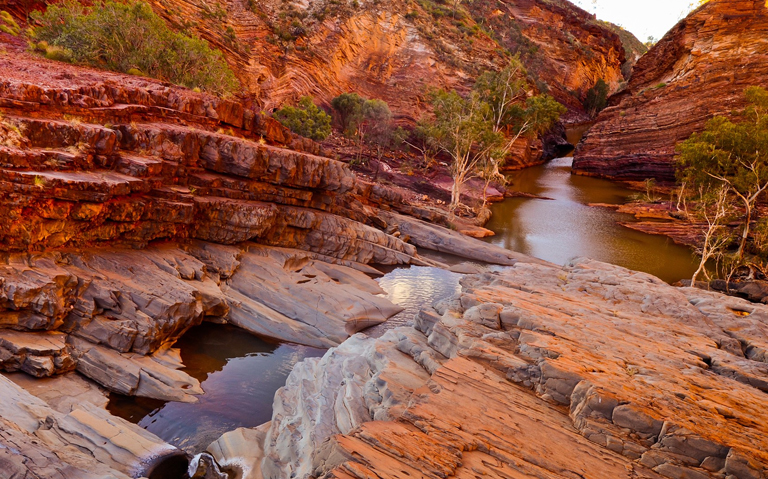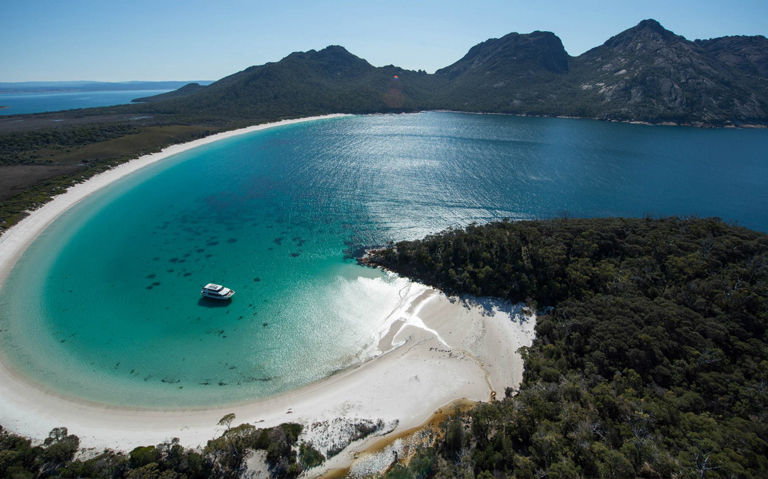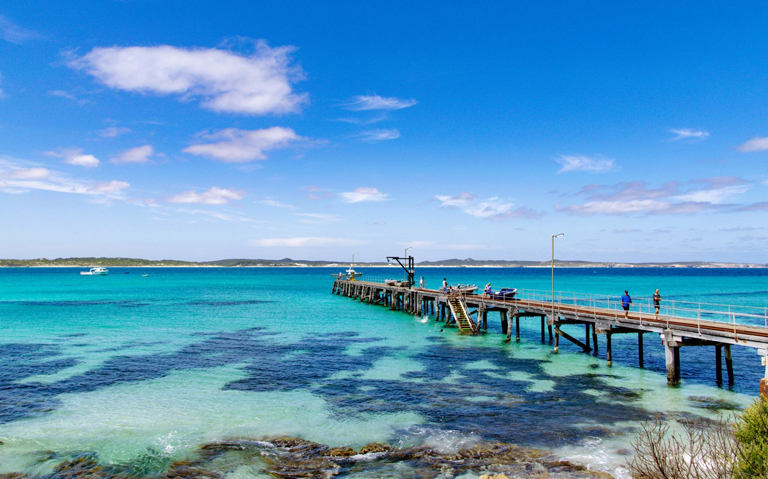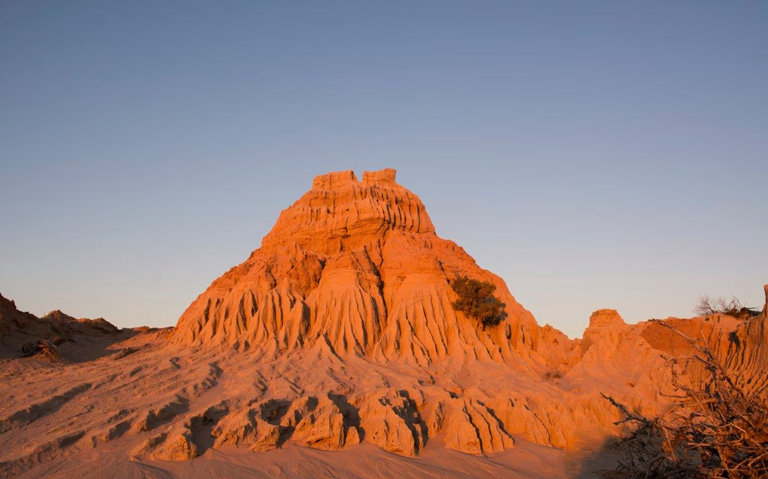Australia is famous for good reason. Iconic natural wonders, epic coastlines, and pure blue seas attract millions of visitors every year. But far beyond the tourist hotspots and Instagram pages, off the beaten track are secret landscapes, remote beaches, hidden waterfalls, and ancient rock formations you’ve (probably) never heard of. We visited five underrated Australian destinations that represent the wildest and most beautiful side of the country. Every single one often skipped by travelers in favor of more popular sights. But trust us, each one is worth going off-piste for.
5 Underrated Aussie Spots Better Than You Think
These five picks each capture a unique Australian spirit: stunning scenery, challenging hikes, quirky fauna and flora, fascinating local history, and real wilderness areas. Whether by 4WD, hike, or day trip, each one is a travel highlight in its own right.
Underrated Australian Destinations
1. Hamersley Gorge, Karijini National Park (WA)

The gorge we first visited, this awe-inspiring, largely unexplored natural wonder carved out over millions of years of shifting earth. Spectacular examples of Australia’s fascinating geology include the swirling red rock formations, clear aquamarine waterholes, perfect swimming holes, and cascading waterfalls. Compared to many similar parks, the beauty of this place is mostly ours to enjoy.
Features to Love:
- Massive walls of vibrant red rock up to 2 billion years old
- Crystal-clear pools, waterfalls for swimming, snorkeling
- Few crowds on hiking trails and photo opportunities
Getting There: From Karratha, it’s a 3.5-hour drive to Karijini National Park in the heart of remote Western Australia. Nearby camping and lodge accommodation are available. The park has entry fees. Remember to check for any permits required for certain areas and be aware of extreme summer temperatures.
2. Wineglass Bay, Freycinet National Park (TAS)

On the east coast of Tasmania, Wineglass Bay is one of the few truly pure white sand beaches left in the world. Tucked away and hard to reach, it’s almost impossible to visit from overseas, and many locals drive past without knowing what they’re missing. But hike or take a boat trip for an out-of-this-world, sparkling white sand beach framed by jagged peaks of white granite.
Reasons to Visit:
- Pristine white sand, turquoise sea
- Great combined with Tasmanian wildlife spotting (wallabies, dolphins)
- Scenic lookout reached by a 2-hour roundtrip hike
Getting There: Freycinet National Park is 2.5 hours drive from Hobart. A valid parks pass is required for entry. The hike to the Wineglass Bay lookout is a well-groomed trail, though steep at times. Cruises of Wineglass Bay are also available from Coles Bay.
3. Vivonne Bay, Kangaroo Island (SA)

Another emerging favorite, Kangaroo Island has similar wildlife and scenery to mainland South Australia. Vivonne Bay, with stunningly blue and shallow water, white powder sand, and protected from the elements. Most important, few crowds to spoil the remote vibe. Ideal for swimming, lounging, and exploring without the mainland chaos. Plus, you’re likely to see kangaroos and echidnas galore (in real life this time!).
Activities:
- Swim, surf, and relax on empty beaches
- Kayak, snorkel in shallow marine-life rich bays
- Walk down the long jetty, visit secret rock pools
Getting There: Kangaroo Island is a short flight or 45-minute ferry ride from Adelaide. Vivonne Bay is about an hour’s drive north of the main town of Kingscote. Various tours and activities are available, including wildlife encounters and water sports.
4. Umpherston Sinkhole, Mount Gambier (SA)

Our tiny garden in the middle of a giant stone cave trick surprised and delighted. Umpherston Sinkhole looks like a normal park from the outside. Until you walk down the steps to explore its botanical wonder. Blooming with ferns, flower gardens, and resident pet possums, it’s hard to believe this little slice of paradise is a natural underground wonder, especially at sunset.
Features to Love:
- Beautiful, overgrown gardens inside a collapsed sinkhole
- Paths through ferns and hanging fountain plants
- A special place for picnics and wildlife at sunset
Pro Tip: Nearby Blue Lake is also unique—a volcano caldera that changes from grey to turquoise each year.
Getting There: Umpherston Sinkhole is located in Mount Gambier, South Australia. It’s easily accessible by car, and open from dawn to dusk. There are ramps and steps leading into the sinkhole garden.
5. Mungo National Park (NSW)

This is off the beaten path. Seriously. Mungo National Park is a stark and rugged outback landscape far from major highways, cities, or water. But that’s exactly what makes it such an unforgettable travel adventure. Nomadic in the oldest lakebeds on earth, fairy-pillow sand dunes shaped by the wind over millennia, the mysterious deep Indigenous history of the land, and epic sunsets complete the story.
Reasons to Go:
- Wild, rugged desert scenery and weird landforms
- Aboriginal rock art and archaeological sites
- Great stargazing without light pollution
Getting There: Mungo National Park is remote. You can drive from nearby Mildura (2 hours), but it’s often recommended to join an outback tour due to the rugged and unsealed roads. Guided tours often include access to restricted areas like the Walls of China.
Comparison Table
| Destination | Standout Feature | State | Best For |
|---|---|---|---|
| Hamersley Gorge | Waterfalls & rock pools | WA | Hiking, secluded swims |
| Wineglass Bay | Crescent beach, hiking | TAS | Nature, beaches, views |
| Vivonne Bay | Blue water, marine life | SA | Wildlife, relaxation |
| Umpherston Sinkhole | Underground gardens | SA | Picnics, photos |
| Mungo National Park | Ancient dunes, culture | NSW | Outback, Aboriginal sites |
Travel Tips for Australia’s Off-The-Beaten-Path Gems
- Research in advance: All of these places are a little out of the way, some requiring 4WD and special permits or licenses. Check park websites or local visitor centers for the latest information.
- Visit outside of high season: Enjoy fewer crowds, more pleasant weather in shoulder season (spring/autumn).
- Follow local rules: The most beautiful, least crowded places often have fragile natural ecosystems or Indigenous cultural significance. Respect signs and guidelines.
FAQs
1. Why visit underrated spots instead of famous ones?
Underrated means fewer crowds, lower prices, more real nature, and great encounters with locals and wildlife.
2. Are these destinations family-friendly?
Most are fine for adventurous families with kids. Check terrain, access, and facilities if with young children.
3. Do I need a guided tour to get to these places?
A car or 4WD is necessary for some, but others have basic facilities or are accessible with tours. For places like Mungo National Park, guided tours offer valuable insights and access to restricted areas.
4. Is it safe to visit these remote areas of Australia?
Totally, but you need to plan carefully. Carry water, food, inform someone of your plans, and check for any alerts/closures, especially regarding weather and road conditions.
Want to leave the crowds behind for some jaw-dropping scenery? Add these 5 underrated Aussie wonders to your bucket list, bring a sense of adventure, and explore a side of Australia more beautiful than you ever imagined!
- Which underrated Australian spots offer the most breathtaking scenery
- How do these hidden gems compare to Australia’s famous tourist destinations
- Why are some lesser-known places in Australia more beautiful than popular sites
- What makes Kangaroo Island and Mount Field National Park stand out
- How can discovering these underrated spots change my perception of Australia